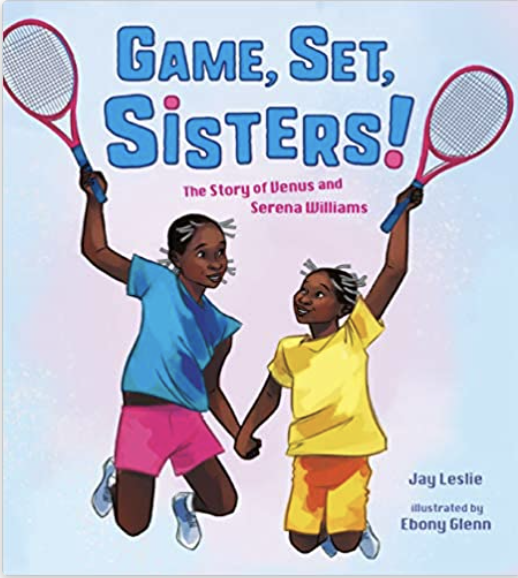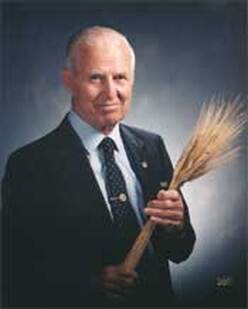Heroes - Lives to Learn From
October
Diligence Self-Control & Patience Perseverance
October
Diligence Self-Control & Patience Perseverance
Milton Hershey (1857-1945)
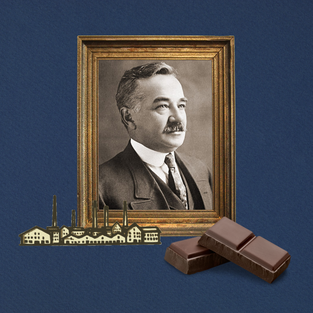
A great model for "try, try, again," Milton Hershey, America's iconic chocolatier, began his life in Pennsylvania Dutch country. The son of German and Swiss parents, who taught him the value of hard work, he helped on the family farm before helping his parents earn cash. He got his first job at about 13, working for a local printer. But bored with the work, he was fired when he dropped his hat in one of the machines! Hershey pivoted to candy (which he observed made people happy), and never looked back. He began to learn the trade of candy making at age 14. That took him from Lancaster (Pennsylvania) to Denver, New Orleans, Chicago and New York. Young Milton experimented with recipes, and founded two failed candy businesses before his hard work and talent paid off.
He got his big break innovating with a caramel recipe, and then with his profits from caramels he bought enough land to provide pasture for the cows he would need to make the milk he would need to make the fine milk chocolate he would need — for the same milk chocolate bars and Hershey's Kisses we love today. Hershey Chocolate Company was born in 1900, and rightly prides itself on a "legacy of goodness." Milton and his wife were unable to have children, so they chose to donate much of their money to causes they cared about. He ensured good living conditions for his workers, and funded a teaching hospital in Hershey, Pennsylvania (the Penn State Milton S. Hershey Medical Center), as well as a school (the Hershey Industrial School, now the Hershey School, which is still offered at no cost to children in need). Besides his obvious fittingness for October (candy!), Hershey is a great example of how diligence and perseverance can pay off with historic success. And when you drive through Hershey, Pennsylvania, you can breathe the smell of goodness and happiness.
He got his big break innovating with a caramel recipe, and then with his profits from caramels he bought enough land to provide pasture for the cows he would need to make the milk he would need to make the fine milk chocolate he would need — for the same milk chocolate bars and Hershey's Kisses we love today. Hershey Chocolate Company was born in 1900, and rightly prides itself on a "legacy of goodness." Milton and his wife were unable to have children, so they chose to donate much of their money to causes they cared about. He ensured good living conditions for his workers, and funded a teaching hospital in Hershey, Pennsylvania (the Penn State Milton S. Hershey Medical Center), as well as a school (the Hershey Industrial School, now the Hershey School, which is still offered at no cost to children in need). Besides his obvious fittingness for October (candy!), Hershey is a great example of how diligence and perseverance can pay off with historic success. And when you drive through Hershey, Pennsylvania, you can breathe the smell of goodness and happiness.
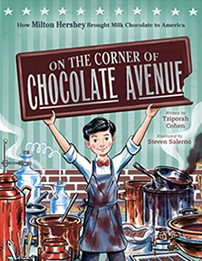
On the Corner of Chocolate Avenue: How Milton Hershey Brought Milk Chocolate to America. Tziporah Cohen. Illustrated by Steven Salerno. Clarion Books, 2022. (1-3) Perseverance, Patience, Diligence, Generosity, Lives to Learn From.
Vivacious illustrations accompany the story of little Milton Hershey, who grew up in poverty in Pennsylvania and persevered through many failed attempts at starting a business before getting his big break making caramels (1883). Then, of course, there is the story of his perfecting the Hershey chocolate bar! The book goes on to tell the story of Hershey's generosity after he made his fortune, remembering his penniless roots.
Vivacious illustrations accompany the story of little Milton Hershey, who grew up in poverty in Pennsylvania and persevered through many failed attempts at starting a business before getting his big break making caramels (1883). Then, of course, there is the story of his perfecting the Hershey chocolate bar! The book goes on to tell the story of Hershey's generosity after he made his fortune, remembering his penniless roots.
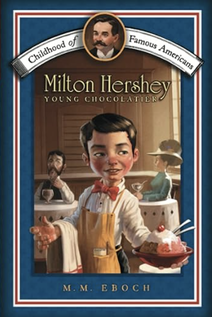
Milton Hershey: Young Chocolatier. M.M. Eboch. Aladdin, 2008. (3-6) Diligence, Perseverance.
Part of the Childhood of Famous Americans series, this fictionalized but still informative biography is a fun read for older children. Readers will learn about Milton Hershey's childhood in poverty, the real issues that he faced with his family of origin, and how he persevered to become a famously successful chocolatier.
Part of the Childhood of Famous Americans series, this fictionalized but still informative biography is a fun read for older children. Readers will learn about Milton Hershey's childhood in poverty, the real issues that he faced with his family of origin, and how he persevered to become a famously successful chocolatier.
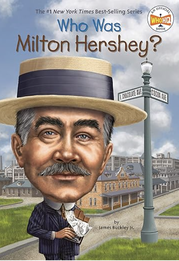
Who Was Milton Hershey? James Buckley, Jr. Illustrated by Ted Hammond. Penguin Workshop, 2013. (3-6) Diligence, Perseverance.
A book from the familiar Who Was series, telling the story of the famous chocolatier who persevered in inventiveness until he made the perfect chocolate bar.
A book from the familiar Who Was series, telling the story of the famous chocolatier who persevered in inventiveness until he made the perfect chocolate bar.
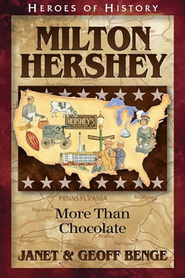
Milton Hershey: More Than Chocolate. Janet Benge and Geoff Benge. Emerald Books, 2012. (6-8) Diligence, Perseverance.
A chapter book for older children that tells the story of Milton Hershey's perseverance through obstacles (including comparisons to his father, who never succeeded in accomplishing his big dreams) to found the most successful chocolate company in history. The "Heroes of History" series places the emphasis on the heroic virtue required to become such a notable figure in history.
A chapter book for older children that tells the story of Milton Hershey's perseverance through obstacles (including comparisons to his father, who never succeeded in accomplishing his big dreams) to found the most successful chocolate company in history. The "Heroes of History" series places the emphasis on the heroic virtue required to become such a notable figure in history.
Venus and Serena Williams: Perseverance, Patience, Self-Control

Tennis legends Venus and Serena Williams are our October 2022 heroines for perseverance, diligence, and lots of grit. Just fifteen months apart in age, the two sisters dominated women's tennis for more than two decades and theirs is an against-all-odds story. Venus (born June 17, 1980) and Serena (September 26, 1981) began life in modest circumstances in Compton, California, but with parents who were all-in on their behalf. Their father Richard and mother Oracene ("Brandy") were tennis enthusiasts, coaching and homeschooling their daughters from age four. Richard's eighty-five page plan for his daughters' success proved a roadmap to his dream and theirs. He was insistent that they learn not just tennis, but focus on their studies, prize hard work and humility, and take time to be kids. But tennis was their passion and they both pursued it doggedly. They entered an affluent white athletes sport as black girls from a working class neighborhood. They faced adversity of all sorts - from racial prejudice and early poverty to overcoming injury and illness. Poster girls for perseverance, these two sisters often played each other for the number one spot in women's tennis while remaining personally close, and snagging twenty-two doubles titles over the years. The wonderful biographies below should give hope to any child who has a sports dream and the will to pursue it.
Image: Edwin Martinez via Wikimedia Commons, cropped. CC-BY-2.0
|
Who Are Venus and Serena Williams? James Buckley Jr. Illustrated by Andrew Thomson. (3-6)
A great choice for third to sixth graders. Rich detail on the girls' upbringing, training, choices and success. Another winner in the "Who Are" series. |
Sisters: Venus & Serena Williams. Jeanette Winter. Beach Lane Books, 2019. (2-4) Patience, Perseverance, Self-Control.
A beautiful story of the Williams sisters and their journey to tennis fame, emphasizing the hard work it took, and the self-control and perseverance that made it possible. Another winner from Jeanette Winter. Serena: The Littlest Sister. Karlin Gray. Illustrated by Monica Ahanonu. Page Street Kids, 2019. (1-3) Patience, Perseverance, Self-Control.
This book focuses on Serena Williams, the youngest of the Williams sisters. |
Game, Set, Sisters! Jay Leslie. Illustrated by Ebony Glenn. (3-5) Perseverance, Patience, Self-Control.
For older readers since it deals with the death of Venus and Serena's older sister in a shooting in Compton, this is a story about the persevering of Venus and Serena's sisterly bond throughout their tennis journeys. |
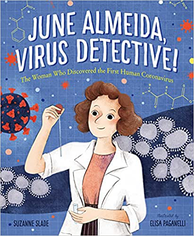
June Almeida, Virus Detective! The Woman Who Discovered the First Human Coronavirus. Suzanne Slade. Illustrated by Elisa Paganelli. Sleeping Bear Press, 2021. (2-6) Diligence, Perseverance
The true story of Scottish virologist, June Hart Almeida, who loved science from the time of her youth. The little girl raced to school each day, consumed with curiosity about the workings of nature. Her passion for understanding deepened when her little brother Harry died of disease and "sadness swallowed the family like a deep, dark hole." How could Harry have been saved? In the 1950s June's parents could not afford to send her to college, but she persevered in her passion for science, working first in a hospital lab, learning to use the new electron microscope. With it, she became a pioneer in virology, designing a system to identify new viruses and photograph them with the microscope. In 1964, she discovered and captured the image of the first human corona virus, and in 1967, published work based on her findings. She earned international fame, and a Ph.D. based on her research. A true story of diligence that is enormously relevant for our times.
The true story of Scottish virologist, June Hart Almeida, who loved science from the time of her youth. The little girl raced to school each day, consumed with curiosity about the workings of nature. Her passion for understanding deepened when her little brother Harry died of disease and "sadness swallowed the family like a deep, dark hole." How could Harry have been saved? In the 1950s June's parents could not afford to send her to college, but she persevered in her passion for science, working first in a hospital lab, learning to use the new electron microscope. With it, she became a pioneer in virology, designing a system to identify new viruses and photograph them with the microscope. In 1964, she discovered and captured the image of the first human corona virus, and in 1967, published work based on her findings. She earned international fame, and a Ph.D. based on her research. A true story of diligence that is enormously relevant for our times.
Celebrating Diligence, Self Control, Perseverance
and the 100th Anniversary of Women's Suffrage (2020)
and the 100th Anniversary of Women's Suffrage (2020)
In 1776 Abigail Adams urged her husband John "to remember the ladies," as they developed a code of laws for the new nation. But in 1917 (when the United States entered World War I to "make the world safe for democracy") American women still did not have the vote. Many wondered what democracy in America meant exactly.... "MR. PRESIDENT, HOW LONG MUST WOMEN WAIT FOR LIBERTY?" placards outside the White House demanded. The fight for women's suffrage had begun nearly a century before, and the women who championed it then and now were exemplars of diligence, perseverance and LOTS of self control (not to mention courage). "Silent Sentinels," they called themselves in the months leading up to Woodrow Wilson's second inauguration. From January to March 1917 in any kind of weather, as many as a thousand suffragists draped in white, purple, and gold stood outside the White House in complete silence with their placards. Organizer Alice Paul warned suffragists not to be provoked into a confrontation, but simply to endure, to stand in silence with their signs ("20,000,000 American Women Are Not Self-Governed"). The women were jeered, spat upon, their signs snatched, and some imprisoned, but they did not engage in violence. (That's self-control!) One Congressman said there was "something religious" about it. They simply stood their ground. And eventually Wilson ceded his. On August 18, 1920 the nineteenth amendment to the Constitution was ratified, establishing Women's Suffrage. The stories of many champions for this great civic right are told below.
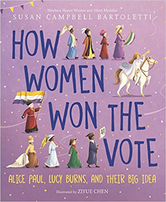
How Women Won The Vote Alice Paul, Lucy Burns, and Their Big Idea. Susan Campbell Bartoletti. Illustrated by Ziyue Chen. Harper Collins, 2020. (3-6)
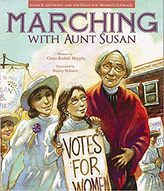
Marching with Aunt Susan. Claire Rudolf Murphy. Illustrated by Stacey Schuett.
Peachtree Publishing, 2017. (2-4) 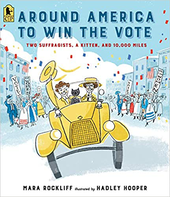
Around America to Win the Vote: Two Suffragists, a Kitten and 10,000 Miles. Mara Rockliff. Illustrated by Hadley Hooper. Candlewick, 2019. (K-3)
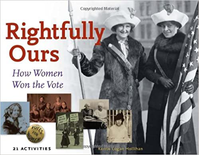
Rightfully Ours. How Women Won the Vote. Kerri Logan Hollihan. Chicago Review Press, 2012. (4-6) (on Epic!)
|
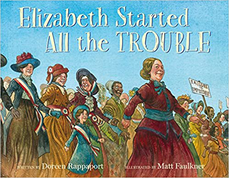
Elizabeth Started All the Trouble. Doreen Rappaport. Illustrated by Matt Faulkner.
Little, Brown Books, 2016. (K-3) 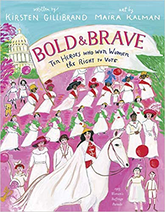
Bold and Brave. Kirsten Gillibrand. Illustrated by Maira Kalman. Knopf Books, 2018. (3-6)
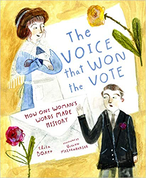
The Voice that Won the Vote: How One Woman's Words Made History. Elisa Boxer.
Illustrated by Mildenberger. Sleeping Bear Press, 2020. (2-5) (on Epic!) 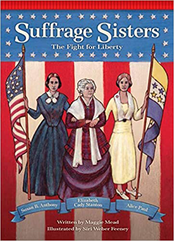
Suffrage Sisters. Maggie Mead. Illustrated by Siri Weber Feeney. Red Chair Press, 2015. (3-5) (on Epic!)
|
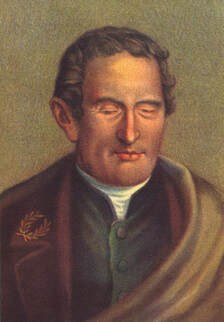
Perseverance - Louis Braille (1809-1852)
Our October hero, Louis Braille, embodied all these virtues and contributed something revolutionary to the world: a tactile alphabet that bears his name, making production of books for the blind possible. Young Louis opened windows on the world of learning to millions of visually impaired.
Braille’s is a story of tragic loss, determination and resilience. Born in the early nineteenth century, the son of a French leather worker, Louis lost his sight at age three. Though his father had told him never to enter his shop without him, young Louis (bored) wandered in one day, and found an awl and strap of leather, and began to create. A slip of the hand sent the sharp awl flying and robbed him of sight in one eye. An infection spread to the other eye, rendering him blind. By four, Louis was compensating for loss of his sight with other senses and cues; he had learned to do many household chores, and his spirit was undaunted. But when he went to school, he longed for books that he could read. A lecture on military cryptography (using dots for sounds) at a school for the blind in Paris was the inspiration for Louis's life’s contribution. By age twelve, Louis had invented an alphabet of raised dots that formed the basis of his system. His alphabet today is virtually unchanged, and appropriately, it bears his name. Here we feature some excellent children’s books about the boy who refused to give up.
Our October hero, Louis Braille, embodied all these virtues and contributed something revolutionary to the world: a tactile alphabet that bears his name, making production of books for the blind possible. Young Louis opened windows on the world of learning to millions of visually impaired.
Braille’s is a story of tragic loss, determination and resilience. Born in the early nineteenth century, the son of a French leather worker, Louis lost his sight at age three. Though his father had told him never to enter his shop without him, young Louis (bored) wandered in one day, and found an awl and strap of leather, and began to create. A slip of the hand sent the sharp awl flying and robbed him of sight in one eye. An infection spread to the other eye, rendering him blind. By four, Louis was compensating for loss of his sight with other senses and cues; he had learned to do many household chores, and his spirit was undaunted. But when he went to school, he longed for books that he could read. A lecture on military cryptography (using dots for sounds) at a school for the blind in Paris was the inspiration for Louis's life’s contribution. By age twelve, Louis had invented an alphabet of raised dots that formed the basis of his system. His alphabet today is virtually unchanged, and appropriately, it bears his name. Here we feature some excellent children’s books about the boy who refused to give up.
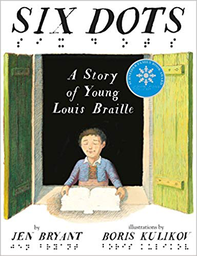
Six Dots. A Story of Young Louis Braille.* Jen Bryant. Illustrated by Boris Kulikov. Alfred Knopf, 2016. (K-3) Diligence, Grit
Written from Louis's perspective, this book introduces us to Braille's childhood, the accident in his father’s shop that rendered him blind, and his frightening entrance into a "dark and dangerous" world. Louis learned to use his other senses, but longed for books that he could read. At a school for the blind, the Headmaster showed students a code the French army was using with dots for sounds. After several years of hard work, Louis developed a tactile alphabet that anyone could read. An inspiring look into the life of a young person who wouldn’t take no for an answer.*Available on Epic! 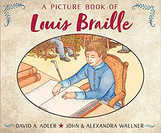
A Picture Book of Louis Braille. David Adler. Illustrated by John & Alexandra Wallner. Holiday House, 2019. Perseverance,
Lives to Learn From. (1-3) Though blinded at age three, Louis never stopped wanting to learn about the world around him. He longed to read books, but there was no way for a blind child to read at this time. When he was taught sonography – the system of writing dots and dashes for sounds - he realized its potential for the blind, and worked tirelessly to perfect a system of raised letters that would be easy to read and write. Beautiful full page illustrations. A new edition of this book will be released on Dec. 10, 2019. |
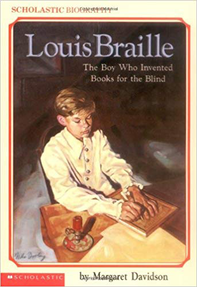
Louis Braille: The Boy Who Invented Books for the Blind. Margaret Davidson. Illustrated by Janet Compere. Scholastic, 1991. (3-5) 80 pages. Diligence, Perseverance
This slender chapter book recounts the extraordinary life of Louis Braille for older children. Colorfully written and poignantly told, the story follows Louis from the onset of his blindness in a French village at age three, to his triumphs learning to do chores without sight, to his school-age battles learning without the benefit of books. When his parish priest heard of a school for the blind in Paris, off went Louis, only to discover that his life’s work would be to invent an alphabet that allowed the blind to read. He did it – at age 12! An amazing story of dedication and persistence in the face of adversity. Mostly text; not a picture book. If your students are good readers, they could read this themselves after listening to Six Dots in class. 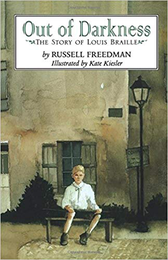
Out of Darkness: The Story of Louis Braille. Russell Freedman. Illustrated by Kate Kiesler. Clarion, 1999. 96 pages. (5-8) This is the Louis Braille story told with the usual depth and sympathy of Russell Freedman, and is beautifully illustrated by Kate Kiesler.
|
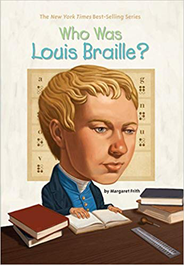
Who Was Louis Braille? Margaret Frith. Illustrated by Robert Squier. Penguin, 2014. 112 pages (3-6)
This 112 page chapter book is written at the third to sixth grade reading level and provides a fuller accounting of Braille’s life with Frith’s characteristic pithiness and charm.
This 112 page chapter book is written at the third to sixth grade reading level and provides a fuller accounting of Braille’s life with Frith’s characteristic pithiness and charm.
|
Diligence - Norman Borlaug (1914-2009)
This Iowa-born prairie farm boy had a passion for growing crops and ending hunger. Father of what as been called “the Green Revolution,” he received his Ph.D. in plant genetics in 1942, and set off to impoverished Mexico to help increase crop yields there. His path-breaking work in the late 1940s resulted in hardier, high-yield wheat strains that vastly improved harvests. (Mexico had been importing wheat and corn to feed its people, but within a decade became an exporter.) For this work, Borlaug won the Nobel Peace Prize in 1970. His services were in demand, and he was called to India and Pakistan, where drought and famine threatened starvation on a mass scale. His work developing higher-yielding strains of wheat and rice helped dramatically increase harvests and avert mass starvation. He has been called “the man who has saved more lives than any other person who has ever lived.” Work ethic, intellectual curiosity, and a passion for helping others, are all exemplified in the life of Norman Borlaug. |
Borlaug’s Legacy
Norman Borlaug was a humble and self-effacing man. When he won the Nobel Peace Prize in 1970, he was dumbfounded, and he urged the Nobel committee to launch instead a Nobel Food and Agriculture Prize. They did not take his advice, so while he continued his own work, Borlaug pursued other avenues. He launched “The World Food Prize” in 1987.
Norman Borlaug was a humble and self-effacing man. When he won the Nobel Peace Prize in 1970, he was dumbfounded, and he urged the Nobel committee to launch instead a Nobel Food and Agriculture Prize. They did not take his advice, so while he continued his own work, Borlaug pursued other avenues. He launched “The World Food Prize” in 1987.
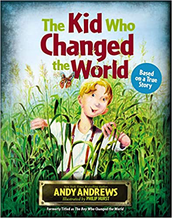
The Kid Who Changed the World. Andy Andrews. Illustrated by Philip Hurst. Tommy Nelson,2014
|
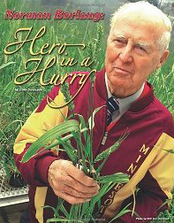
|
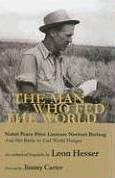
The Man Who Fed the World: Nobel Peace Prize Laureate Norman Borlaug and His Battle to End World Hunger
Leon Hesser. Durbin House, 2006. |
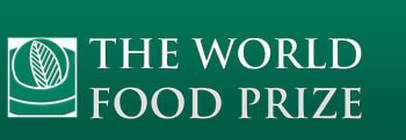
The World Food Prize organization (founded by Norman Borlaug and based in Des Moines, Iowa) awards a substantial sum annually to the individual who has “done the most to help done the most to advance human development by improving the quality, quantity or availability of food in the world.” Food Prize Laureates have made huge strides improving rice production, developing high protein maize, eradicating plant diseases and much more. Students will find a wealth of information about hunger and those who combat it on The World Food Prize website at: www.worldfoodprize.org




